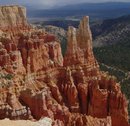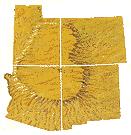Geology of the Bryce Canyon area
|
|
The exposed geology of the Bryce Canyon area shows a record of deposition that covers the last part of the Cretaceous period and the first half of the Cenozoic era in that part of North America. The ancient depositional environment of the region around what is now Bryce Canyon National Park varied from the warm shallow sea in which the Dakota Sandstone and the Tropic Shale were deposited to the cool streams and lakes that contributed to the colorful Claron Formation that dominates the park's amphitheaters.
Other formations were also created but were mostly eroded following two major periods of uplift; one around 70 million years ago (creating the Rocky Mountains) and another 10 to 15 million years ago (creating the Colorado Plateaus). The uplift caused vertical joints to form which were much later preferentially eroded to form the free-standing pinnacles, badlands, and monoliths we see today. The formations exposed in the park are part of the Grand Staircase.
| Contents |
The Grand Staircase
The rocks exposed in Bryce Canyon are about 100 million years younger than those in nearby Zion National Park and the rocks exposed in Zion are younger than those in the Grand Canyon to the south (see geology of the Zion Canyon area and geology of the Grand Canyon area). There are, however, shared rock units between all three, creating a supersequence of formations that geologists call the Grand Staircase. Together the formations of the Grand Staircase record nearly 2000 million years of the Earth's history. Bryce Canyon's formations are the youngest known units in the Grand Staircase. Younger rock units, if they ever existed, have been removed by erosion.
Deposition of exposed rock units
Cretaceous Seaway and aftermath
The Dakota Sandstone consists of a basal conglomerate and fossil-rich sandstone. This formation was probably laid down late in Cretaceous time in a shallow sea, which divided North America that geologists call the Cretacous Seaway. This formation is the oldest one exposed in the Bryce Canyon area but the youngest one exposed in the Zion area to the southwest. In the Bryce Canyon area this formation can be seen in the Paria Valley where it is found as a lithified blanket sand that probably accumulated on beaches, in lagoons, and in coal swamps as the Cretaceous Seaway transgressed (advanced inland) over the region.
The Tropic Shale was deposited as mud and silt in the same sea, but only after it became deeper and calmer in the area. This formation is found in the lower elevations of the park and contains fossilized ammonites.
Formations of sandstone and shale such as the Straight Cliffs, Wahweap, and Kaiparowits were laid down late in Cretaceous time only to be uplifted and mostly eroded away as that geologic period ended, creating unconformities. Outcrops of these rock units can be seen in the southern part of the park at lower elevations.
Uplift was caused by a mountain-building episode called the Laramide orogeny, which lasted from late Cretaceous to early Paleocene time. This hoisted the once low uplands upward while low-lying basins between them gradually subsided.
Claron Formation
A large system of shallow lakes, covering several thousand square miles, filled basin floors in a large part of eastern and central Utah and south western Montana in Eocene time. Large quantities of lakebed sediments were laid down in this system during the 20 million years of it existence from about 63 to 40 million years ago. Climate changes and cycles caused the lakes in the system to expand and shrink through time. As they did so, they left beds of differing thickness and composition stacked atop one another in the Bryce Canyon area;
- pure limey oozes were deposited in the deepest waters,
- this graded into calcium-rich mud in less deep water,
- into calcium poor muds closer to shore, and
- to various sand and cobble deposits near shore.
These were later lithified into the non-uniform fossil-poor set of limestones, mudstones, sandstones, and conglomerates that make up the Claron Formation (formally known as the Wasatch Formation). Geologist Clarence Dutton called the iron oxide-rich lower member of the Claron the Pink Cliffs series due to its colorful appearance. The fragile spires called hoodoos, for which Bryce Canyon is famous, are almost entirely composed of this member of the Claron. Monoliths form from the White Cliffs member. Most arches and natural bridges in the park, including the famous Natural Bridge, were carved from sandstone beds in the Claron.
Colorado Plateaus and erosion
Younger rock units were laid down but were mostly removed by subsequent uplift-accelerated erosion. Outcrops of these formations can be found in the northern part of the park and in a few places on the plateau rim. Among these are the 50 to 100 foot (15 to 30 m) thick Oligocene-aged Boat Mesa Conglomerate (made of Claron-derived clastic material) and the Pliocene to early Pleistocene-aged Sevier River Formation (made of brownish-gray sandstone with some conglomerates).
Around 16 million years ago in Miocene time, the Colorado Plateaus region was uplifted several thousand feet (over a kilometer) from near sea level. Associated with the uplift were tensional forces that segmented the region into different plateaus, including the Paunsaugunt. Tensional forces in Nevada to the west were so great that the crust was spread thin, creating the Basin and Range Province. Consequently tensional deformation of the Colorado Plateaus was greatest in its western margins. Long north-south trending faults, such as the Sevier and the Paunsaugunt, were created as well.
As North America slowly drifted northward the climate cooled and then became wetter. Eventually headward erosion of the Paunsaugunt Plateau in late Tertiary and early Quaternary time created Bryce Canyon's amphitheaters and differential erosion and frost wedging created the hoodoos. Ice ages during the Pleistocene kept snow and ice at higher elevations all year.
References
- Geology of National Parks: Fifth Edition, Ann G. Harris, Esther Tuttle, Sherwood D., Tuttle (Iowa, Kendall/Hunt Publishing; 1997) ISBN 0-7872-5353-7
- Secrets in The Grand Canyon, Zion and Bryce Canyon National Parks: Third Edition, Lorraine Salem Tufts (North Palm Beach, Florida; National Photographic Collections; 1998) ISBN 0-9620255-3-4
- National Park Service: Bryce Canyon geology field notes [1] (http://www2.nature.nps.gov/geology/parks/brca/) [2] (http://www2.nature.nps.gov/geology/parks/brca/photos.htm) (images)
Further reading
- DeCourten, Frank. 1994. Shadows of Time, the Geology of Bryce Canyon National Park. Bryce Canyon Natural History Association.
- Kiver, Eugene P., Harris, David V. 1999. Geology of U.S. Parklands 5th ed. John Wiley & Sons, Inc.
- Sprinkel, Douglas A., Chidsey, Thomas C. Jr., Anderson, Paul B. 2000. Geology of Utah's Parks and Monuments. Publishers Pressde:Geologie des Bryce-Canyons







